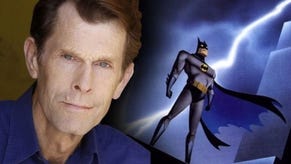Batman: Arkham Asylum
Cape fear.
Less engaging, there are also Riddler trophies lurking around the map, chattering Joker teeth to destroy, interviews with Arkham's famous inmates lying around on tapes and mysterious messages from the tragic Amadeus Arkham, spelling out the bleak history of his asylum. The story is linear but the gameworld is not, and at any time you can wander off and sniff out hidden bonuses. There are 240 such secrets to find, and unlike most other games that pad themselves out with hunt and gather elements, these are surprisingly compelling. It's hard to miss some, but that's just enough to tickle the OCD gland that makes you think you should probably try and find some more. Each earns you a sizeable chunk of useful XP as well as character biographies and rendered statues of in-game characters. Far from essential, but still compulsively collectable all the same.
Also prolonging your pleasure are the Challenge Rooms, unlocked through gameplay, with extra ones available as DLC. Split between combat and stealth, these not only test your ability to dispatch foes quickly and effectively, but also set you specific tasks to earn medals. You might have to defeat all enemies using Silent Takedowns, to use an obvious example. As an optional extra, they're fun to dip into, and leaderboard obsessives will enjoy the ranked competition they provide.
Tying all these disparate elements together is a satisfying story from the pen of Paul Dini, whose stewardship of the seminal 1990s animated series should allay any fears that anyone will behave out of character. In actual fact, by placing the game in the realistically restricted confines of Arkham, and by having the unpredictable Joker as the antagonist, the story doesn't really have to stretch too much to accommodate the requirements of a videogame. Joker is playing with Batman, after all, and so it makes sense that he'll be opening up new areas only when you've performed specific tasks.
Also carried over from the animated series are Kevin Conroy as Batman and Mark Hamill as the Joker. Conroy's task is the less glamorous one - he has to be stoic and determined at all times, and does it with customary aplomb. It's Hamill's game, though, and his cackling performance ensures that the Joker's presence is felt throughout, even though he's rarely on-screen. Much like every other element of the game, the dialogue is virtually seamless. Knock out a sentry while he's talking on his radio and Joker's script changes accordingly. "Is that you, Bats?" he coos. It's undeniably cool, and a great way to make you feel immersed in the world.

Complaints are minor. For all the attention to detail, the game-world is a disappointingly lifeless place. Only certain objects are affected by physics, so you can have a ventilation grate that clatters out of the way as you pass, while a small chair becomes an impassable barrier. There are also moments where character logic gives way to videogame lore. It seems highly unlikely that Batman would travel anywhere without a gas mask of some kind, yet poisonous fumes are used as obstacles several times. Ditto for electrified floors, even though Batman clearly isn't running around in his bare feet.
It's also a shame that the last chunk of gameplay loses some of its hard-earned lustre, devolving into a series of depressingly ordinary boss battles of the "repeat this pattern three times" variety. It's a testament to the game's narrative that I don't really want to go into too much detail, for fear of spoiling some cool moments, but showdowns with Bane, Killer Croc and Poison Ivy all feel a little anti-climactic.
One villain who does come out of the game smelling of roses (even if they are decaying) is the Scarecrow. Several times during the course of the story, you'll be subjected to his fear-inducing gas, and the way Batman's nightmares seep into the gameworld is quite brilliant. One sequence, close to the end of the game, even calls to mind Kojima's meta-textual monkey-business with Psycho Mantis. It's just a shame that these superb twists on the formula are always followed by some awkward side-on platforming dream sections. In a game already full of different gameplay mechanics, it feels like a step too far and the fussy control makes them a fleeting inconvenience rather than a refreshing break in style.
However, most of the gameplay concerns are minor when taken in the context of how much Arkham Asylum gets so gloriously right. Rarely does a game do a character justice in such a satisfying way. Arkham Asylum finds room for every major aspect of Batman's enduring appeal, and it does so in a game compelling enough to work even without its masked star. Fans of the caped crusader really shouldn't hesitate - this isn't just the best grown-up Batman game, it's the best superhero game, bar none.







